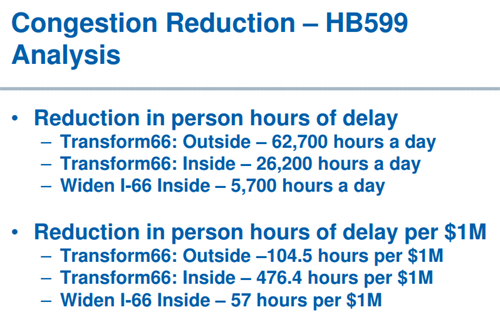For I-66, outside-the-beltway lawmakers say “toss the facts, widen baby widen”
A group of Virginia state legislators from outside the beltway are urging Governor McAuliffe to widen I-66 inside the beltway, rather than go forward with VDOT’s transit and tolls proposal. But years of data say the multimodal proposal would be more effective.
What’s happening with I-66
Over the course of 2015, the Virginia Department of Transportation settled on a plan to change how I-66 inside the beltway operates.
Instead of the current configuration where the entire highway is HOV-only in the peak direction during rush hour, the peak direction would become HOT, meaning single-occupant cars could travel on it if they pay a toll, while HOV cars remain free.
In exchange for letting single-occupant cars onto a highway they’re currently not allowed to use, toll revenue would go to improving transit.
Then, after a few years of operating like that, VDOT would study how traffic changed, and either widen I-66 or opt not to.
That plan had been gaining steam all through 2015, as VDOT did the planning to take it from rough concept to fully fleshed out project.
Some just want a wider highway
Then the Virginia General Assembly began its 2016 session, and a prominent bill proposes to kill the project, replacing it with a straight-up widening of I-66. The bill’s author, western Fairfax / eastern Loudoun delegate Jim LeMunyon, consistently advocates for bigger highways, and has a history of trying to cut transit and bike/ped funding.
Governor McAuliffe, who supports the transit and tolls plan, says he won’t veto the bill if it reaches his desk on the back of support from Northern Virginia’s delegates.
That prompted a group of seven other lawmakers, all from the outer suburbs of Northern Virginia, to urge VDOT to drop the transit and tolls plan, and support widening only.
No lawmakers from inside the beltway, where this plan would actually take place, signed on to the letter.
Analysis says the transit and tolls plan is better
VDOT’s transit and tolls plan has been in the works for 13 years. Studies in 2003, 2009, and 2012 built towards the 2015 proposal, all of which determined a widening-only approach wouldn’t work very well.
Most recently, in 2015 VDOT ran three projects through a sophisticated computer model called “HB-599,” to see how they would affect traffic congestion. The three projects:
- “Transform66 Inside,” the transit and tolls proposal
- “Widen I-66 Inside,” a widening-only alternate
- “Transform66 Outside,” an entirely separate project outside the beltway, that’s less controversial.
The outcome: For inside the beltway, the transit and tolls proposal is a far more effective project than widening only. It reduces congestion on I-66 much, much more than widening only would. Never mind the added mobility and benefits to car-free urbanites. Simply in the terms of reducing highway congestion, the model says the transit and tolls proposal is better.
Be objective, unless being objective doesn’t produce what you want
Ironically, the HB-599 process is Jim LeMunyon’s own brainchild. It’s the result of a bill he sponsored in 2012 to force Northern Virginia to objectively evaluate the congestion reduction effects of major projects.
But now the HB-599 results are in, and alas, they aren’t what LeMunyon hoped for. According to LeMunyon’s own hand-picked metrics, the transit and tolls project is better than just widening.
But none of that matters to the outer suburban politicians who just want bigger highways. For them, I-66 seems to be a case of “Damn the numbers! Widen baby, widen!”
What will happen?
Until a bill to block tolls becomes law, VDOT is continuing to move forward with the transit and tolls plan. If the plan stays alive, construction will begin this summer, and the project will open in the summer of 2017.
With Governor McAuliffe threatening to withhold a veto, some of Northern Virginia’s lawmakers will need to come out in support of the transit and tolls plan. Virginians can contact their lawmakers via the Coalition for Smarter Growth.


